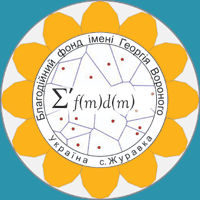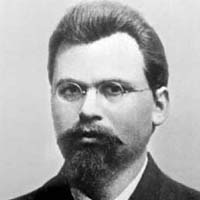|
* * * * * * * * * * *
The main domain which G.Voronoi chose for his research was the number theory.
It was the basic scientific direction of research in St.-Petersburg at that
time. At the second half of the XIX century such well-known scientists as Professors
P.L.Chebyshev,
A.A.Markov, Ye.I.Zolotarev were working here in this domain and, as a result of
their efforts a scientific school arose which later on was called
"Petersburg [St.-Petersburg was also called Petersburg and Petrograd] School of the
Number Theory". Professor A.A.Markov became a scientific leader of G.Voronoi.
The Voronoi's debut at the mathematical scientific society took place on
December 2, 1888. His report was based on his own research ─ it was the proof
of one property of Bernoulli numbers by his own method. Professor Markov
treated Voronoi's presentation with great
approval. This first success increased Voronoi's enthusiasm, so he
continued his research and intensified it with wonderful persistence. A.Markov
proposed him to prepare the paper for publication, but Georgy Voronoi, exacting
to himself, wanted first to refine the obtained result and to generalize it. He
continued his work next summer, in Zhuravka, and only when his exposition
became sufficiently clear and precise, did he send the paper to Communications
of Kharkov Mathematical Society.
In autumn of 1889, G.Voronoi
brilliantly passed his final exams and defended his candidate thesis (which
corresponds to the present term "diploma thesis"), the theme was
concerned with Bernoulli's numbers. In November, 1889, he was kept at the University
to prepare for master's degree exams. The representation necessary for it was
signed by all the leading mathematician ─ professors:
A.A.Markov, O.M.Korkin, Yu.V.Sokhots'kii and K.O.Posse. Simultaneously,
G.Voronoi gained a scholarship and was appointed a supernumerary teacher at the Petergof
Progymnasium. Thus, his future was
ensured. At last, he became Olia's
fiancé.
Scientific interests of the young researcher were concentrated further
on the theory of irrationalities of the
third degree. Two large works written by him in this direction made the
foundation of his magister dissertation (defended
in 1894) and doctorate dissertation (which was published in Warsaw in 1896).
Academician D.Grave wrote in this connection in 1934: "Georgy Voronoi is a Ukrainian mathematician
of genius. While being at Petersbourg university he was busy with investigation
of cubic domain which he performed with remarkable success and made a great discovery
in this field. He extended the algorithm of continued fractions to a cubic
domain ... This extension had been sought in vain by all the most outstanding
mathematicians through the XIX century. Hence the Voronoi algorithm was found.”
The obtained result was so striking that Prof. A.Markov could not
believe the correctness of the Voronoi proof and could not dare to approve his
work. In this connection D.Grave
asserted, that Markov by telegraph (this fact was known to him fromhad invited Voronoi to his office and proposed him
to calculate the unit for one equation, for it Markov had found artificially one
unit. Voronoi had calculated for three hours, and found the second unit, So, it
was verified that the algorithm really exists.
After the defence of his magister dissertation, G.Voronoi worked almost all
his life at the Warsaw
University. Lecturer's
duties took too much time because the staff of the University included only two
professors of mathematics except Voronoi. For this reason, Voronoi was forced
to lecture the students of different
terms gathering them in one class. For example, Voronoi lectured the courses of
the theory of numbers and probability theory to students of the 3rd and 4th
years. These courses were given by Voronoi once in two years.
Voronoi treated his lectures very seriously. He tried to acquaint his
students with recent achievements of science and with his own new results. To
ensure better understanding of the course by the students, Voronoi repeatedly asked for permission to give additional
lectures on analytic geometry. [Though such supplementary lectures were unpaid for, a
lecturer had to obtain the permission from not only Dean and Rector, but also
from Trustee of the Educational District]
From autumn of 1898, Voronoi also became a Dean of Mechanics Faculty of
the Warsaw Polytechnical Institute. In 1898, the Moscow Mathematical Society
elected G.Voronoi as one of its members.
In August of 1898, Voronoi took part at the Xth Conference of Russian naturalists
and physicians in Kyiv. Next year, in St.-Petersburg, Voronoi gave three
reports at the XIth Conference. In one of them, he proposed an original method
for generalized summation of divergent series. Later, the same technique was
independently discovered by Dutch mathematician
N.E.Nörlund and became known for
a long time as Nörlund's method. In 1904, Voronoi made two reports at the
International Mathematical Congress held in Heidelberg.
In 1903-1904, there were issued two large papers of Voronoi on analytic number
theory, which became a new direction of his studies. The results obtained by
Voronoi were highly appreciated by mathematicians. As a consequence, he was
elected Corresponding Member of the St.-Petersburg Academy
of Sciences in 1907.
G.Voronoi usually spent his summer vacations with his family in
Zhuravka.
Here he continued his research and in his mathematical diary [Several note-books
of G.Voronoi's mathematical diary are kept in the Institute of Manuscripts
mentioned above] there are notes that he wrote it in Zhuravka.
In 1905-1907, both Warsaw
University and Warsaw
Polytechnical Institute were closed
because of revolutionary events. A number of their professors. and
Voronoi among them, were sent to Novocherkassk,
where Donskoi Polytechnical Institute was founded. Voronoi worked there about a
year as Dean of the Mechanics Faculty. In autumn 1908, studies at the Warsaw University
were renewed and
Voronoi returned to Warsaw.
His teaching load was enormous because he remained a single professor for some
time. Later, Voronoi gave part of his courses to Prof. I.R.Braitsev, who was
transferred from Warsaw Polytechnical Institute to assist him. In that time,
Voronoi lectured a new course on mathematical analysis and wrote a textbook on
the basis of his lectures. In 1909-1911, it was published
at Warsaw University, Braitsev being its editor.
For many years, G.Voronoi developed arithmetic theory of quadratic
forms. He possessed a peculiar habit to think his ideas over and over again in
his mind until they matured and acquired an appropriate perfect form. Then he
wrote down the obtained result very fast. Voronoi started to write his memoir
on the theory of parallelohedra on 25.03.1907. In 10 days, he completed the
work comprising 106 pages of a large size written compactly and in small
letters. But already on 5.04.1907, he rewrote the text making numerous
corrections. Only after the third
revision, Voronoi sent his manuscript to the journal edited by A.L.Krelle
with the following covering letter:
"For twelve years I have been studying properties of parallelohedra. I
can say it is a thorny field for investigation, and the results which I received
and set forth in this memoir cost me dear...
Three-dimensional parallelohedra are playing now an important role in
the theory of crystalline bodies, and crystallographers have already put attention
to properties of these strange polyhedra, but till now the crystallographers
were satisfied with the description of parallelohedra from a purely geometrical
point of view. I noticed already long ago that the task of dividing the
n-dimensional analytic space into convex congruent polyhedra is closely
connected with the arithmetic theory of positive quadratic forms
This paper, which was certainly the highest manifestation of his great
intelligence, became his swan-song.
The intense intellectual work required from him large efforts, but Voronoi
lacked strong health. Some years before physicians had found a disease of the
gallbladder which caused him many physical and mental sufferings. In that time,
he worked in a new field of indefinite quadratic forms, he spoke about it with
high emotions. As appears from his mathematical diary, Voronoi gave the first
record about his results on the theory of indefinite quadratic forms on
20.02.1908 in Novocherkassk.
Adverse conditions of his life in Novocherkassk
had led to a hard
exacerbation of his disease. In view of this situation,
Vorono\"{\i} hurried to put down his thoughts in his mathematical diary:
"I am doing very well in the problem which I am working at; meanwhile my
health is ever getting worse. Yesterday for the first time I got a clear idea
of the algorithm which is to solve all problems concerning the theory of forms
which I am working at, but just yesterday I had a strong attack of a bilious
colic which prevented me from working in the evening and was keeping me awake
almost all night. I am so afraid lest the results of my long efforts, which I
got with a great deal of hard work, should perish with me, while it is so
difficult to put them in order. Many things I can only guess by some feeling,
which just now, when I am ill, became sharper...”
Before his departure for Warsaw G.Voronoi told his friend and colleague I.Braitsev:
"Doctors forbid me to work. But I have noticed myself that a strong
mental effort will always cause a reaction in my ailment. The thing is they do
not know what it means for me to give up my pursuits of mathematics. My wife alone
knows that mathematics is being the purpose of my life for me, it is everything.”
Physicians believed that G.Voronoi needed a long-term holiday and advised
him to go to Carlsbad [Now it is Karlovy
Vary in Czech
Republic] for treatment.
But he decided to spend all summer, as in previous years, in Zhuravka, where he
had always restored his health. Indeed, Voronoi felt fine but at the end of
October in Warsaw
his disease passed on to the acute form, and Georgy Vorono\"{\i} died on 7(20)th
of November. p3
| 


